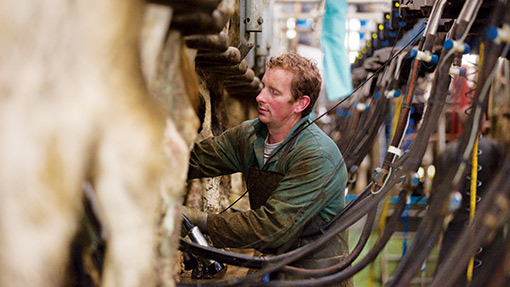4 ways to improve your milking parlour routine

It’s very easy for a parlour routine to become established, but time spent undertaking a review of exactly what does happen during milking time can often highlight areas where improvements can be made.
And that can mean quicker milking times, improved udder health and even more milk in the tank.
That’s the advice of Simon Marsh of Dairy Spares, who says it’s often worth getting someone else to observe a milking routine to provide an objective assessment and suggest where changes could make a difference.
See also: Practical advice on moving to a rotary parlour
“Often things are being done that are having an adverse impact on how cows are milked but it takes another pair of eyes to see it. It’s very easy to get into a rut but many farmers would be surprised how much time can be shaved off milking time by making subtle changes they have never even thought of.
These changes are beneficial not only to the operator but also to the cows.”
But while older parlours can also appear to be a barrier to improved efficiency at milking time, Simon Marsh says there are four key areas where changes can be made.
1. Testing and servicing of the entire milking machine
The test will check the vacuum level and vacuum reserve as well as the pulsation.
During a year, working several hours a day, vacuum levels will fluctuate, pulsation will alter and the vacuum reserve will change.
While these changes may not initially be evident, over the weeks and months they can have a significant impact on how the parlour is working. Left unchecked, this can result in cell count problems as the vacuum level drops.
Milking times can slowly start to increase if vacuum levels and pulsation problems occur. A dairy engineer may take four or five hours to undertake a complete test but it’s well worth it. Engineer charges should be about £35/hour.
2. Pulsation
Pulsators work at 60 beats/min so calculating how many hours the parlour is working shows just how much work this part of the system is doing.
Pulsators operating in older parlours are far less efficient than those currently being installed in new set-ups.
A farmer may have become used to a specific length of time it takes to milk, but improving the pulsation of the system can make a big difference to milking time, possibly taking 45 minutes off a three-hour session.
A new pulsation system would cost about £4,000 for a typical 20-point parlour, excluding installation.
3. Vacuum reserve
Depending on the size of the herd, a lot of vacuum is often needed to work feeders, gates and cluster removal and there also needs to be enough in reserve.
A lot of farmers don’t have adequate vacuum reserve to thoroughly wash the system after milking. The more reserve there is the better the wash routine can be. That means better hygiene and a lower Bactoscan.
A bigger vacuum pump may be needed – cost would be about £1,600 for a battery pump and a motor, excluding any vacuum line update.
4. Claw-bowl capacity
Many parlours have a 150ml claw-bowl capacity on the cluster, but in many cases this is inadequate for the volume of milk the claws are expected to cope with.
All producers are striving for higher yields but a 150ml capacity in the claw-bowl will create a bottle neck of milk flow because the milk coming out of the udder simply can’t get away fast enough.
Increasing the claw-bowl capacity to 350-400ml is now advisable – it means the milk is getting away more efficiently and milking times can be reduced.

